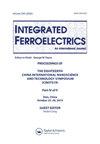Broadband 1.53 μm Emission and McCumber Analysis of Er 3+ Doped Alkali Oxyfluorophosphate Glass for Fiber Optic Communication Material
IF 0.7
4区 工程技术
Q4 ENGINEERING, ELECTRICAL & ELECTRONIC
引用次数: 0
Abstract
AbstractEr3+ doped alkali oxyfluorophosphate glasses were prepared by the melted quenching method and characterized their optical and photoluminescence properties. Firstly, the chemical compositions of glasses were varied by changing alkali fluoride (LiF and NaF), whereas the concentration of Er3+ was fixed at 1.00 mol%. The optical absorption pattern and intensity were resemblance. Broadband 1.53 μm emission was one prominent peak of Er3+ in glass and the highest emission intensity was obtained for NaF glass under the stimulating at 521 nm. Secondly, the NaF glass was prepared by variation of Er3+ concentration (0.1, 0.5, 1.0, 2.0, and 4.0 mol%). The emission intensity of glasses increases with an increase in Er2O3 concentration up to 2.00 mol% and decreases for higher Er2O3 concentration, because of the concentration quenching effect. Broadband emission was observed that it covers three telecommunication windows: S, C, and L bands. The absorption and emission cross-section of 2.00 mol% of Er3+ doped alkali oxyfluorophosphate were found to be 1.3895 x 10−20 cm2 and 1.7248 x 1020 cm−2, respectively by using the McCumber theory. Both values led to the estimate of the internal gain coefficient for 4I13/2→4I15/2 emission transition. The gain coefficient is positive when P is higher than 40%. All results point out that Er3+ doped alkali oxyfluorophosphate glass could be useful for fiber optic communication material.Keywords: Alkali oxyfluorophosphate glassErbiumfiber optic communication materialMcCumber theory Disclosure StatementNo potential conflict of interest was reported by the author(s).Additional informationFundingThe authors would like to thank the National Research Council of Thailand (NRCT) and Thailand Science Research and Innovation (TSRI) for supporting this research. J. Kaewkhao would like to thank the National Research Council of Thailand (NRCT) under Research Grants for Talented Mid-Career Researchers Project (Project number N41A640097).掺er3 +碱氟氧磷玻璃光纤通信材料的宽带1.53 μm发射及麦坎伯分析
摘要:采用熔融淬火法制备了掺ter3 +的碱氧氟磷酸盐玻璃,并对其光学和光致发光性能进行了表征。首先,通过改变碱氟(LiF和NaF)来改变玻璃的化学组成,而Er3+的浓度固定在1.00 mol%。光吸收模式和光强相似。Er3+在521 nm处的激发下获得了最高的发射强度。其次,通过改变Er3+的浓度(0.1、0.5、1.0、2.0和4.0 mol%)制备NaF玻璃。当Er2O3浓度达到2.00 mol%时,玻璃的发射强度随Er2O3浓度的增加而增加,随Er2O3浓度的增加而降低。宽带发射被观察到,它覆盖三个电信窗口:S, C和L波段。利用McCumber理论,得到了2.00 mol% Er3+掺杂的氟氧膦酸盐的吸收截面为1.3895 × 10−20 cm2,发射截面为1.7248 × 1020 cm−2。这两个值都可以估算出4I13/2→4I15/2发射跃迁的内部增益系数。当P大于40%时,增益系数为正。结果表明,掺Er3+的碱氟氧磷玻璃可作为光纤通信材料。关键词:氟氧膦碱玻璃;铋;光纤通信材料;作者要感谢泰国国家研究委员会(NRCT)和泰国科学研究与创新(TSRI)对这项研究的支持。J. Kaewkhao在此感谢泰国国家研究委员会(NRCT)在杰出中期职业研究人员研究资助项目(项目编号N41A640097)下的资助。
本文章由计算机程序翻译,如有差异,请以英文原文为准。
求助全文
约1分钟内获得全文
求助全文
来源期刊

Integrated Ferroelectrics
工程技术-工程:电子与电气
CiteScore
1.40
自引率
0.00%
发文量
179
审稿时长
3 months
期刊介绍:
Integrated Ferroelectrics provides an international, interdisciplinary forum for electronic engineers and physicists as well as process and systems engineers, ceramicists, and chemists who are involved in research, design, development, manufacturing and utilization of integrated ferroelectric devices. Such devices unite ferroelectric films and semiconductor integrated circuit chips. The result is a new family of electronic devices, which combine the unique nonvolatile memory, pyroelectric, piezoelectric, photorefractive, radiation-hard, acoustic and/or dielectric properties of ferroelectric materials with the dynamic memory, logic and/or amplification properties and miniaturization and low-cost advantages of semiconductor i.c. technology.
 求助内容:
求助内容: 应助结果提醒方式:
应助结果提醒方式:


